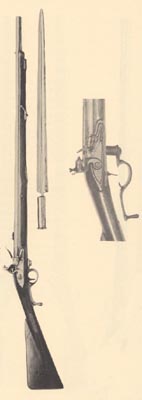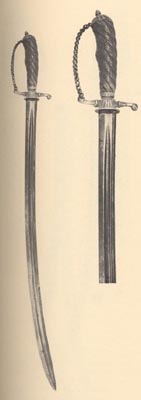
"A soldier must be very unfortunate
indeed who shall be wounded by a common musket at 150 yards and as to
firing at a man at 200 yards with a common musket, you may just as well
fire at the moon and have the same hopes of hitting your object."
-Major George Hanger (Moore, 62)
British-made Brown Bess flintlock musket, c. 1759
Whether you're roughing it in India, marching in Connecticut, or quieting the crowds at home, this Brown Bess standard-issue musket is the infantryman's closest friend in the British Army. With a 46-inch barrel, this standard-issue musket can hit targets of any nationality accurately at 100 yards (although not much farther-just ask George Hanger.) (Moore, 62)
Although fairly sturdy, these weapons still take a good deal of practice to use with any efficiency. One must reload after every shot with a series of twenty four motions, loading gun powder and lead musket ball and through the muzzle of the gun, forcing them down to the flashpan with a 'ramrod.' (Keep in mind that these motions must be performed in the face of heavy enemy fire.) (Frey, 100-101)
Even after the gun is loaded, there's plenty that could
go wrong: too much powder could cause an interior explosion that could
seriously injure both the gun and the soldier. Load too little powder,
and the ball will not hit its target with enough velocity to inflict damage.
Due to these complications, even after hundreds of hours of training,
experienced British infantrymen could rarely fire more than two rounds
a minute.
(Frey, 100)


Officer's Breech-Loading Ferguson Rifle, c. 1777
A far superior weapon to the common "Brown Bess," chances are you'll never see it in action. Developed by Captain Patrick Ferguson, this rifle much shoots faster, much father, and with greater accuracy than standard British firearms.
Used by several hundred officers (mostly friends of Captain Ferguson) in the Southern campaigns of the American Revolution, a trained officer could fire this weapon up to six times in a minute at a range of 200 yards, and reload while advancing forward-a major technical feat. (George, 136)
Unfortunately, due to bureaucratic inefficiencies and Ferguson's death
in action in 1780, the rifle will never be mass produced, although many
contend that the organized mobilization of this weapon could win the
American Revolution for the British in a matter of months. (Moore, 63)
Swords and Bayonets

"[British success] must greatly rest
on the bayonet."
-General Burgoyne
Silver-hilted hunting sword, 24-inch blade, c. 1774
As the century progresses, swords have become almost totally obsolete in the infantry, and by the American Revolution, swords are reserved only for high-ranking officers. Accordingly, many officers opt to wear ornate hunting swords as symbols of their rank. Often ornamented with precious, expensive materials such as silver and ivory, these status symbols boldly distinguish commissioned officers from their martial and social inferiors. (Moore, 127)

![]()
Nearly all members of the British infantry carry bayonets, and all soldiers
undergo extensive training in bayonet-warfare. The triangular knives
can easily be affixed to the muzzle of any standard musket by its cylindrical
socket, invented at the end of the 17th century.
The blades range anywhere from 15 to 30 inches in length, with a variety
of widths. (Moore, 186) Bayonets may be used as spears in close combat
and direct charges or as a "shock weapon": a weapon used for
intimidating visual effect (as they were often used in war, as well
as domestic riots.)
During the American Revolution, most main British attacks involve a
bayonet charge, and several critical British victories in North America
were won through the disciplined employment of bayonets-including the
midnight raid on the camp at Mad Anthony Wayne (over 200 Americans casualties),
and a battle at Guilford Court House in North Carolina. (Frey, 102)
As much as any other development in armaments, the bayonet has revolutionized
18th Century warfare with its devestating tactical success.